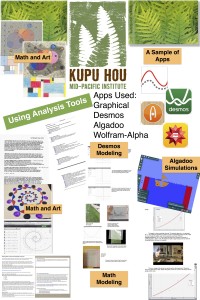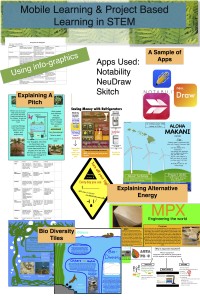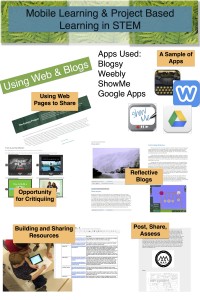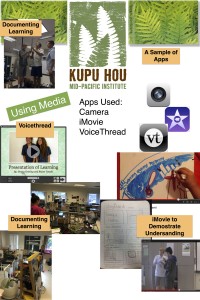So here it is, Saturday, March 12, 2011. We just spent the last hour online using Elluminate web conferencing software to host a collegial conversation (also known as a tuning protocol) with Jen Peterson, Humanities Teacher, High Tech High International on her questions/dilemma:
How can I best structure a project that is open-ended enough to leave room for creativity and individual choice while still setting myself up for successfully managing it?
we had 15 people in our conference including folks from three islands in Hawaii, California, Toronto and a teacher from Finland. Our goal was to help broaden Jen’s thinking about her problem, and in the process learn from our community ideas that we individually might not have come up with.
We have been doing this now for about a year–all the archives are located here:
http://gse.hightechhigh.org/collegial_conversations.php
but this was worth blogging about, because what unfolded showed the power of a small group of focused educators–none of them experts, per se, all of them committed to thinking deeply about a single issue in front of them. And so I wanted to paste out what transpired in the chat window as questions to her project idea. There are wonderful gems in the conversation that I think anyone doing student driven, project or problem based learning could glean.
Jen explained that she has a project in which she wants her students to do creative writing in the voice of an author/style that will elevate their thinking about their writing. She found herself challenged in making sure that her students chose authors/voice that push their thinking and their ability to address adopting a style that challenged them.
Here are excerpts from the chat window as we looked at clarifying questions to understand her problem better (clarifying questions are designed to help the participants understand the conditions of the dilemma better–they’re not designed to make the presenter think):
Moderator (Karen Harris): c: your question is for this literature project in particular
———————
zrandall: C: How long do students have to write for this short story project?
———————
Moderator (mark hines (honolulu)): you have been doing this particular project how long?
———————
Moderator (mark hines (honolulu)): what percentage of kids need guidance in picking the ‘just right author’?
———————
zrandall: C: What structures are in place for promoting creativity in the project? Are there guidelines you’ve set up to allow for maximum creativity?
———————
Moderator (mark hines (honolulu)): has this issue come up for you before?
———————
Matt Piercy: C–So the challenge is stimulating creativity rather than hampering it, while still having clear “boundaries”?
———————
Matt Piercy: C–How many students actually take the “low” road and do not challenge themselves?
———————
Jane 1: C : Have the students written numerous short stories in their own style previously?
C: Are they familiar with identifying keep aspects of writing styles?
———————
Moderator (mark hines (honolulu)): do you show them examples of what the product should be like? – made by you, or past students?
———————
Moderator (mark hines (honolulu)): does the length of the project change the importance of this issue?
———————
Jane 1: C: Do the students have an opportunity to “rewrite” a familiar story (as a group) in a different(agreed upon) author’s style?
———————
brendon allen to Karen Harris: C: Where do graphic novels fall in all of this? Approved or not?
———————
Moderator (Laura McBain 1) to Karen Harris: are they all reading the same book
———————
Mauri Laakso / Maurice Walley: Do you have any fictional elements witch engaging the children in the context?
———————
brendon allen: Where do graphic novels fall in all of this? Approved or not?
———————
brendon allen: Are Plays acceptable
———————
Nathan J: Is there much peer assessment in the project?
Here are excerpts from the chat window as we looked at probing questions to help the presenter think about her problem deeper ( probing questions are designed to help the presenter broaden their thinking about their particular issue, and potentially new ways to view it and solve it):
Moderator (Karen Harris): p: similar to protocols limiting boundaries to open dialogue or creative freedom have you thought of how this can happen with your book choice?
———————
Matt Piercy: P–Have you considered allowing choice but giving parameters? i.e. Must be a British author? Must be an author from the 20th century? Must be __________ genre?
Or, providing a list of 30 authors they could select from? Maybe having students read excerpts or a whole book of a new author and then emulating that style in their own writing?
———————
Moderator (mark hines (honolulu)): how do the students respond to your guidance in getting “in bounds’?
———————
Moderator (Jesse Wade Robinson): P: In what ways do you want to challenge the students?
———————
zrandall: P: Is the goal to have students writing to their passions, or is it more about pushing out of their comfort zones?
———————
Moderator (mark hines (honolulu)): is the concern being driven more by making sure they fit into a range you want or the issue of supporting things outside your expertise?
———————
Moderator (Jesse Wade Robinson): p: What are the management issues you run into when trying to provide more freedom and challenge?
———————
Moderator (mark hines (honolulu)): when you did this 2 years ago did the same issue come up? how did you handle it then?
———————
zrandall: P: How do you define success for your students in this writing project?
———————
Moderator (mark hines (honolulu)): does showing them examples change the way they respond to the project – does it have the impact you desire?
———————
Moderator (mark hines (honolulu)): what is your hunch that might bring the bar up for their thinking?
———————
Mauri Laakso / Maurice Walley: Do you have any fictional elements witch engaging the children in the context?
———————
Moderator (Laura McBain 1) to Karen Harris: P; what has worked before for your projects?
———————
Moderator (Laura McBain 1) to Karen Harris: P: Have you asked the students your question?
———————
brendon allen: What do you define as “Success” in “Managing” the project for yourself?
———————
brendon allen: Is writing a short story new for your students?
———————
Ms. H: Have the kids read book reviews from critics who might provide a different voice concerning something like Twilight? Perhaps they might read them and realize that they sell widely but are not of quality?
———————
brendon allen: Do you see the writing process a good litmus test for the quality of the source, or do you prefer being the filter for choice?
Here are excerpts from the chat window as we broke into smaller groups–the next step of this protocol as the participants talk amongst themselves about the issue, and the presenter quietly listens and takes notes. These are some of the reflections that came out of the conversations from the two groups:
zrandall: I agree. I think she’s being really thoughtful about her students, pushing them to be creative and yet trying to go beyond what they are used to seeing out there
———————
Jane 1: I like the push, too, it’s very challenging to write in a style unlike one’s own but can really push the writing to a new level with practice.
———————
Jane 1: Writing is such a solitary activity at times, I was wondering what effect group work might bring to the project.
———————
zrandall: Pushing creativity is difficult, and I wondered what the success was for her in this project. It seems students who push themselves might have an effect on the kids who are struggling
———————
zrandall: I like the aspect of the group conversation that might push students more than teacher feedback
——–
sean connors 3: All the time the students ask us for examples or exemplars… especially the ones who are confused as to what the expectations are of them…
———————
zrandall: I noticed this in the digital storytelling project I did…very loose objective was to write a defining moment and it wasn’t until student feedback and critique that they realized they could tell other stories
———————
Jane 1: To take it a little further, for those who are really struggling, I wondered if they preselected an author together, wrote their own stories and had dialogue about whether they were hitting the mark in terms of the “new” style. Using the critique process to push each other.
———————
zrandall: I would like to know what Jen thinks the heart of the project is and how many times she’s allowing students to change their story ideas and push their thinking. I like that idea of partnerships…but I see how it would be important to still write thier own piece
———————
Jane 1: Matt – that’s kind of the thought I was trying to get at in my last post. Writing in the chat is tricky – not sure if it’s clear.
———————
Nathan J: As someone mentioned earlier, limits do often promote creativity, so I like the idea of defining the styles for them and working gradually towards more freedom
as the groups talked a notetaker summarized some of their thinking on the whiteboard which was then brought out for group conversation–here are the notes from the two group whiteboards:
creating ownership and empowered. Great project. The just right fit for students. Since only some students take the low road, not a universal problem.
Get the students to do more regulate/converse about why they are choosing what they read. Utilize leverage within the class. Dynamic of how to choose.
Group conversation – they facilitate further pushing of the community
the notion of all students choosing different voice–management nightmare–quite a challenge
opportunities for students to give feedback to each other? Work together in the actual writing? Scaffolding–try technique together then break apart
what is the heart of the project? How often can students change their voice/choice during the project?
This is a fun way to pay homage to writers they admire
starting with autonomy/choice
consistent support from teacher and for creativity
not dumbing down the project
is choice truly being given?
Have students “make their case”
dialogue on choice and widening the choice field is worthwhile
bring in outside people? Real world?
Bring in team choices to “defend” their work
students advocating for their creative passions
bring in a librarian’s perspective
after this, the presenter had 5 min. to come back to the group about how the conversation had broadened/challenged/opened up her perspective.
In the conversations above, there is a wealth of knowledge. One of the challenges in education we have, is not that the solution has to come from the outside, but creating both the time and the structure for internal capacity to be built and leveraged to expand teachers thinking. On my campus (Mid-Pacific Institute) and I would argue on any campus there is already most if not all of the collective wisdom it should take to help teachers grow, design, and deliver engaging, rigorous learning experiences for our kids. The challenge for schools, and primarily their administration is figuring out how to design a cultural landscape in their learning institution that recognizes AND takes advantage of this wealth of knowledge.
***one caveat to mention–the information above is what transpired in the chat window and whiteboard space only. This is maybe only one third of the full conversation that occurred, as the primary vehicle to promote the conversation is audio through the microphones. If you go to the link I posted above, you can hear and watch the entire hour-long conversation unfold, but even just looking at this lens of textual chat, you capture of vibrant, energetic community conversation that I think is the best hope any school has in transforming their learning culture into a 21st century community of practice.****
My two cents anyhow






